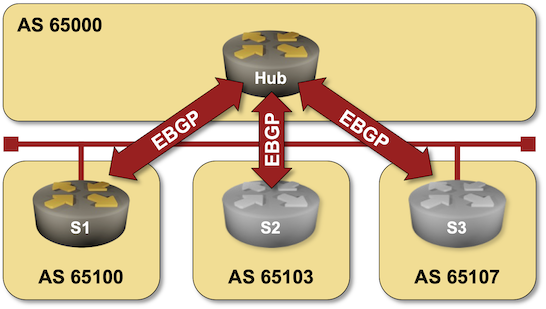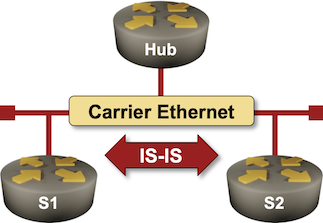Blog Posts in March 2025
Passive BGP Sessions
The Dynamic BGP Peers lab exercise gave you the opportunity to build a large-scale environment in which routers having an approved source IP addresses (usually matching an ACL/prefix list) can connect to a BGP route reflector or route server.
In a more controlled environment, you’d want to define BGP neighbors on the BGP RR/RS but not waste CPU cycles trying to establish BGP sessions with unreachable neighbors. Welcome to the world of passive BGP sessions.

Click here to start the lab in your browser using GitHub Codespaces (or set up your own lab infrastructure). After starting the lab environment, change the directory to session/8-passive and execute netlab up.
Response: Any-to-Any Connectivity in the Internet
Bob left a lengthy comment arguing with the (somewhat black-and-white) claims I made in the Rise of NAT podcast. Let’s start with the any-to-any connectivity:
From my young millennial point of view, the logic is reversed: it is because of NATs and firewalls that the internet became so asymmetrical (client/server) just like the Minitel was designed (yes, I am French), whereas the Internet (and later the web, although a client/server protocol, was meant for everyone to be a client and a server) was designed to be more balanced.
Let’s start with the early Internet. It had no peer-to-peer applications. It connected a few large computers (mainframes) that could act as servers but also allowed terminal-based user access and thus ran per-user clients.
Worth Reading: On Writing
One of the most significant problems engineers face when trying to improve their online presence is the “How do I start writing?” roadblock (hint: publishing bland AI-generated slop won’t get you far unless you aim to become a Thought Leader).
Zvi Mowshowitz collected links to over a dozen different writing styles, starting with JRR Tolkien. I’m pretty sure you’ll find something useful in that vast collection.
netlab 1.9.6: Static Routes to Default Gateways
Last week, I had to push out netlab release 1.9.6 to address a particularly nasty Python dependency hell to make netlab work (again) on Ubuntu 24.04 (more details). The release also brought these goodies (and a bunch of bug fixes):
- Add default gateway (including anycast- and VRRP gateway )as a valid next-hop for static routes
- Rewrite the default gateway processing and add IPv6 default gateways on links without anycast or VRRP gateways
- Set libvirt MTU to 9500 on bridge-based networks to avoid the “transparent fragmentation” on Linux bridges.
- Use device- or node variables to specify the Juniper vMX license file.
… updated on Monday, March 24, 2025 12:40 +0100
IPv6 and the Revenge of the Stupid Bridges
This blog post describes another “OMG, this cannot possibly be true” scenario discovered during the netlab VRRP integration testing.
I wanted to test whether we got the nasty nuances of VRRPv3 IPv6 configuration right on all supported platforms and created a simple lab topology in which the device-under-test and an Arista cEOS container would be connected to two IPv6 networks (Arista EOS is a lovely device to use when testing a VRRP cluster because it produces JSON-formatted show vrrp printouts).
Most platforms worked as expected, but Aruba CX, Cumulus Linux with NVUE, and Dell OS10 consistently failed the tests. We were stumped until Jeroen van Bemmel discovered that the Arista container forwards IPv6 router advertisements between the two LAN segments.
Routed Interfaces on Layer-3 Switches and Internal VLANs
In the Router Interfaces and Switch Ports blog post, I described why we have switch ports and routed interfaces on layer-3 switches. Another blog post in the same series described the conceptual architecture of a layer-3 switch:
- All interfaces are connected to a VLAN-aware switch
- The switch interfaces could be access or trunk interfaces1.
- Each VLAN in a VLAN-aware switch can be connected to an internal router through a VLAN interface.
However, that’s not how we configure layer-3 switches. There’s a significant gap between the conceptual configuration model and the internal architecture:
Comparing IP and CLNP: Network State Summarization
In the previous blog posts, we discussed how TCP/IP and CLNP reach adjacent nodes and build ARP/ND/ES caches and how they reach off-subnet nodes. Now, let’s move from the network edge into the network core and explore how the two protocol stacks reduce the amount of information they have to propagate in routing protocols.
While I’m not exactly an OSI fan, I must admit they got many things right (and IPv6 copied those ideas), but TCP/IP is a clear winner in this aspect.
Worth Reading: Standards for ANSI Escape Codes
I encountered the Escape sequences (named after the first character in the sequence) while programming stuff that would look nicely on the venerable VT100 terminals (not to mention writing one or two VT100 emulators myself).
In the meantime, those sequences got standardized and (par for the course) extended with “proprietary” stuff everyone uses now. Julia Evans did a great job documenting the state of the art. Thanks a million!
Arista EOS Spooky Action at a Distance
This blog post describes yet another bizarre behavior discovered during the netlab integration testing.
It started innocently enough: I was working on the VRRP integration test and wanted to use Arista EOS as the second (probe) device in the VRRP cluster because it produces nice JSON-formatted results that are easy to use in validation tests.
Everything looked great until I ran the test on all platforms on which netlab configures VRRP, and all of them passed apart from Arista EOS (that was before we figured out how Sturgeon’s Law applies to VRRPv3) – a “That’s funny” moment that was directly responsible for me wasting a few hours chasing white rabbits down this trail.
Lab: IS-IS Designated Router Election
Like OSPF, IS-IS needs a router to originate the pseudo-node for a LAN segment. IS-IS standards call that router a Designated Intermediate System (DIS), and since it is not responsible for flooding, it does not need a backup.
Want to know more? The Influence the Designated IS Election lab exercise provides the details (and some hands-on work).

The Linux Bridge MTU Hell
It all started with an innocuous article describing the MTU basics. As the real purpose of the MTU is to prevent packet drops due to fixed-size receiver buffers, and I waste spend most of my time in virtual labs, I wanted to check how various virtual network devices react to incoming oversized packets.
As the first step, I created a simple netlab topology in which a single link had a slightly larger than usual MTU… and then all hell broke loose.
Worth Reading: Traffic Steering into LSPs
You can use SR-MPLS, MPLS-TE, or an SDN controller to build virtual circuits (label-switched paths) across the network core. The controller can push the LSPs into network devices with PCEP, BGP-LU, or some sort of NETCONF/RESTCONF trickery.
Unfortunately, you’re only half done once you have installed the LSPs. You still have to persuade the network devices to use them. Welcome to the confusing world of traffic steering explored in the Loopback as a Service blog post by Dmytro Shypovalov.
netlab 1.9.5: New Cumulus Linux(NVUE) and Junos Features
Jeroen van Bemmel and Stefano Sasso contributed tons of new device features for the netlab release 1.9.5:
Cumulus Linux (NVUE):
- VXLAN and EVPN
- VLAN-aware router (VLAN subinterfaces) functionality
- VRF route leaking
- VRF-aware BGP and full RFC 8950 support (IPv4 BGP AF over regular IPv6 BGP session)
- BGP allowas_in and EBGP multihop
Comparing IP and CLNP: Reaching Off-Subnet Nodes
The previous blog post in this series discussed how TCP/IP and CLNP reach adjacent nodes and build ARP/ND/ES caches. Now let’s move one step further: how do nodes running IPv4/IPv6 or CLNP discover the first-hop router that could forward their traffic to off-subnet nodes they want to communicate with?
Capturing Traffic in Virtual Networking Labs
When I announced the Stub Networks in Virtual Labs blog post on LinkedIn, I claimed it was the last chapter in the “links in virtual labs” saga. I was wrong; here comes the fourth part of the virtual links trilogy – capturing “on the wire” traffic in virtual networking labs.
While network devices provide traffic capture capabilities (usually tcpdump in disguise generating a .pcap file), it’s often better to capture the traffic outside of the device to see what the root cause of the problems you’re experiencing might be.
Podcast: The Rise of NAT
When Ned Bellavance asked me to be a guest on the Chaos Lever podcast talking about NAT, I replied, “and why do you hate me so much?”
However, it turned out one can have a fun conversation about a controversial topic. For more details, listen to The Rise of NAT on Chaos Lever. I hope you’ll enjoy it ;)
